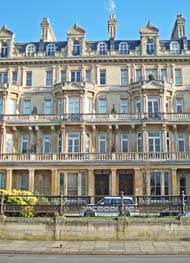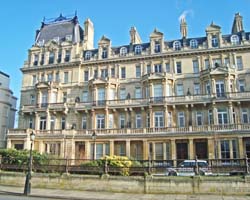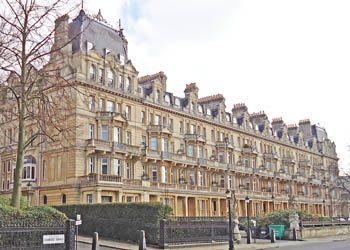Kitchener
House
8 Cambridge Gate, Regent's Park, NW1 4JX
Medical
dates:
Medical
character:
Rehabilitation (military)
Kitchener House opened in
February 1917 under the auspices of the Joint
War Committee. It
was
a Club which followed the lines laid down by Miss Julie
Helen Heyneman at California House,
established for the
benefit of Belgian convalescent servicemen. The novelist and
playwright, Mr John
Galsworthy (1867-1933), who had
visited California House the previous autumn, was so taken with its
methods and aims that he offered his residence in Cambridge Gate to
provide similar accommodation for British disabled, provided Miss
Heyneman undertook the organisation of the Club.
Kitchener House was one of the first education clubs where wounded British soldiers and sailors (not officers) still in hospital could go in their hours of leave to learn languages and useful occupations "to keep their faculties alert and their minds from rusting". The lack of space in military hospitals created a problem for ambulant patients, as there was nowhere for them to go. The Club, on the other hand, provided premises for useful activities - although grave doubt were initially expressed as to whether British servicemen would want to attend and whether they would take advantage of the opportunities provided.
The Club had a recreation room overlooking Regent's Park, supplied with easy chairs, newspapers, writing implements, a piano, a bagatelle board and other games, etc. Lunch and tea were provided in a Dining Room and there were several rooms on the top floors where classes were held in carpentry, wood carving, frame-making, composition, gilding, and in other handicrafts, such as lacquering boxes and gesso ornamentation. French and Spanish were taught and, later, Dutch. The utmost was done to provide transport for the severely disabled to and from their hospitals. Sometimes as many as 100 people attended during the day.
During 1917 almost 6,000 patients attended the Club, with 35% attending classes. From January to August 1918 some 5,000 came, with over 50% attending classes, despite their difficulties with transport, bad wounds and often through bad weather.
In August 1918 the Club premises were closed for two weeks for cleaning.
In September 1918, when the need to re-educate discharged servicemen for civilian life was recognised, the War Office requested that these patients, either attending Out-Patients Departments or awaiting admission to Queen Mary's Hospital in Roehampton, also be permitted to join.
Despite the success of the Club, it received little support from the Press and, more seriously, from the hospitals themselves. After two years of its opening, only one in a hundred patients was aware of it, while no authority within the hospitals was prepared to encourage patients, especially those condemned to remain in hospital for a long period, to take advantage of the Club's facilities and classes. Nonetheless, the way the Club was organised did later provide a general scheme for occupational and vocational training in hospitals under the London District Command.
In October 1918 Lord Leverhulme gave the Kitchener House organisation the use of Upper Heath House, Heath Street, for use as Club premises during and for six months after the war.
Presumably the Kitchener House Clubs closed in 1919.
Kitchener House was one of the first education clubs where wounded British soldiers and sailors (not officers) still in hospital could go in their hours of leave to learn languages and useful occupations "to keep their faculties alert and their minds from rusting". The lack of space in military hospitals created a problem for ambulant patients, as there was nowhere for them to go. The Club, on the other hand, provided premises for useful activities - although grave doubt were initially expressed as to whether British servicemen would want to attend and whether they would take advantage of the opportunities provided.
The Club had a recreation room overlooking Regent's Park, supplied with easy chairs, newspapers, writing implements, a piano, a bagatelle board and other games, etc. Lunch and tea were provided in a Dining Room and there were several rooms on the top floors where classes were held in carpentry, wood carving, frame-making, composition, gilding, and in other handicrafts, such as lacquering boxes and gesso ornamentation. French and Spanish were taught and, later, Dutch. The utmost was done to provide transport for the severely disabled to and from their hospitals. Sometimes as many as 100 people attended during the day.
During 1917 almost 6,000 patients attended the Club, with 35% attending classes. From January to August 1918 some 5,000 came, with over 50% attending classes, despite their difficulties with transport, bad wounds and often through bad weather.
In August 1918 the Club premises were closed for two weeks for cleaning.
In September 1918, when the need to re-educate discharged servicemen for civilian life was recognised, the War Office requested that these patients, either attending Out-Patients Departments or awaiting admission to Queen Mary's Hospital in Roehampton, also be permitted to join.
Despite the success of the Club, it received little support from the Press and, more seriously, from the hospitals themselves. After two years of its opening, only one in a hundred patients was aware of it, while no authority within the hospitals was prepared to encourage patients, especially those condemned to remain in hospital for a long period, to take advantage of the Club's facilities and classes. Nonetheless, the way the Club was organised did later provide a general scheme for occupational and vocational training in hospitals under the London District Command.
In October 1918 Lord Leverhulme gave the Kitchener House organisation the use of Upper Heath House, Heath Street, for use as Club premises during and for six months after the war.
Presumably the Kitchener House Clubs closed in 1919.
Present status (January 2013)
The building is now a private residence.

The doorway to No. 8 is behind the front of the parked car (above and below).


Cambridge Gate was built of Bath stone during 1875-1877 facing Regent's Park. During WW1 it also housed the Hospital for Nursing Sisters at No. 9 and, after the war, the Almeric Paget Clinic at No 2.
(Author unstated) 1917 Kitchener House. A club for wounded sailors and soldiers. British Journal of Nursing, 27th October, 270.
(Author unstated) 1918 Care of the wounded. British Journal of Nursing, 4th May, 311.
Galsworthy J 1918 Kitchener houses. Clubs for men in hospital. Akaroa Mail and Banks Peninsula Advertiser 83 (3762), 4.
Heyneman JH 1918 Educational clubs for wounded sailors and soldiers. Reveille 2, 314-318.
Reznick JS 2010 John Galsworthy and Disabled Soldiers of the Great War. Manchester University Press.
http://socialarchive.iath.virginia.edu
www.oac.cdlib.org
Return to home page